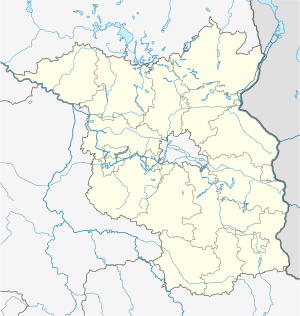Homeyen Bridge
Coordinates: 52 ° 25 ′ 1 ″ N , 12 ° 33 ′ 43 ″ E
| Homeyen Bridge | ||
|---|---|---|
| The Homeyenbrücke over the Brandenburg Niederhavel | ||
| use | Street | |
| Convicted | Grillendamm | |
| Subjugated | Havel | |
| place | Brandenburg on the Havel | |
| construction | Composite steel bridge (since 2010) | |
| completion | 1216 (first building) 1946 |
|
| location | ||
|
|
||
The Homeyenbrücke is a road bridge over the Brandenburg Niederhavel in the urban area of the independent city of Brandenburg an der Havel . It leads the Grillendamm over the Havel .
history
A connection between the old town and the long-distance trade route to the east and Brandenburg Castle, today's cathedral island, is documented as early as 1216. The name Homeyenbrücke first appeared in a document from 1384. Before that, it was also referred to as the Krakow Bridge , an indication of the course of the trade route to the east. In order to enable a problem-free journey on the river for the emerging shipping in the city, a drawbridge and a bridge house were built for the first time in 1574 as accommodation for the bridge servants. The bascule bridge , which was always wooden until then , was only replaced by a concrete bridge in 1936 as the last of the former bascule bridges in the city. In the early history of the city of Brandenburg, there was a well-secured castle on the cathedral island. Impenetrable, swampy and water-rich areas protected this castle. With the foundation of the old town and the new town at the end of the 12th century, the castle lost its strategic importance. The inhabitants of both cities built navigable dams to the north and east of the castle. A Homeyen bridge was mentioned in connection with the construction of these dams in 1217 . The Homeyenbrücke was right in front of the old town mill gate and a front gate protected it from enemy attacks. At the end of the Second World War , the Homeyen Bridge was blown up in 1936 and rebuilt in 1946 and opened again on July 20, 1946. The bridge was on the list of monuments of the city of Brandenburg an der Havel. For several years, the Homeyen Bridge could only be used with restrictions on one side, as it was no longer able to cope with traffic. On March 16, 2009 the bridge was finally closed to road traffic and demolished. A modern steel composite bridge was released for the increased car traffic in spring 2010.
Name interpretation
Several historians have studied the meaning of the word homeye or homeide . Prof. Dr. Otto Tschirch again states that homeye, homeide appears in a whole series of Low German cities from Aachen to Elbing. As Homeie even Hameide , Hameye , Homeye or Homeyde , one of a medieval is fortification superior fortification called. It was mostly used to protect bridges or smaller customs posts. According to Scheller, it is also used to designate a guard house or a watchtower.
photos
See also
literature
- Marie-Luise Buchinger: City of Brandenburg on the Havel. Outer districts and incorporated places. (Monument topography of the Federal Republic of Germany, Monuments in Brandenburg, Volume 1.2). Wernersche Verlagsgesellschaft, Worms 1995. ISBN 3-88462-115-7
- Chronicle of the city of Brandenburg. Ed. Urban History Working Group [City of Brandenburg an der Havel] in the Brandenburgischer Kulturbund e. V., Verlag B. Neddermeyer, Berlin 2003, ISBN 3-933254-40-X .
- Hans-J. Uhlemann: Berlin and the Märkische waterways. transpress Verlag Berlin, various years, ISBN 3-344-00115-9
- Writings of the Association for European Inland Shipping and Waterways eV various years. WESKA (Western European shipping and port calendar), Binnenschifffahrts-Verlag GmbH Duisburg-Ruhrort. OCLC 48960431
cards
- Folke Stender: Editorial team Sportschifffahrtskarten Binnen 1 Nautical publication Verlagsgesellschaft ISBN 3-926376-10-4 .
- Author collective W. Ciesla, H. Czesienski, W. Schlomm, K. Senzel, D. Weidner: Shipping maps of the inland waterways of the German Democratic Republic 1: 10,000, Volume 3.Editor: Wasserstraßenaufsichtsamt der DDR, Berlin 1988 OCLC 830889996
Web links
Individual evidence
- ↑ Book studies of the Sassian-Low German language mainly based on the written monuments in Wolfenbüttel, Dr. Karl FA Scheller , printed in the Princely Orphanage, Braunschweig 1826, p. 37 ( ... homeide a guard house, watchtower, from which the POMEIBA in Algermann, which has caused so many controversies in the Braunschweig magazine, may have come about through incorrect reading ... )





